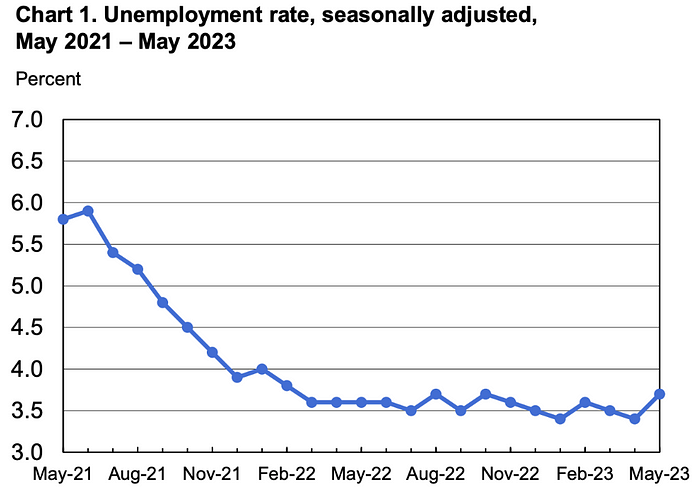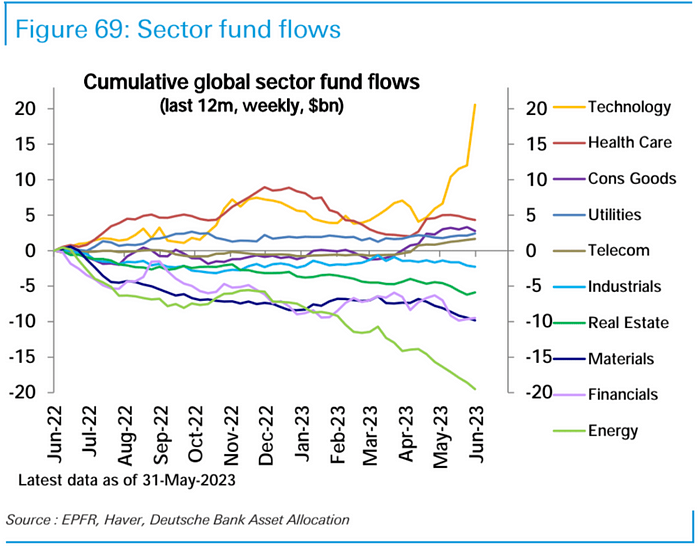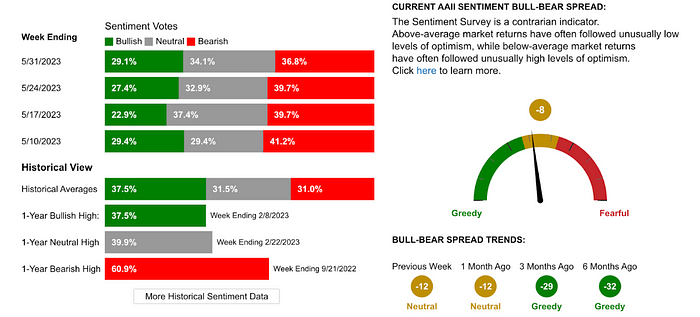Duet Protocol Global Market Chat Recap — 20230605
Gm gm Dueters,
Nice to see you again in our community hours. I hope you enjoyed our weekly global market chat in which we hope to share market news and insights and help everyone get ready for the coming trading week!
We also hope that with the knowledge you get from our sharing, you can perform outstanding trading skills on our RWA (Real World Asset) perpetual future trading platform, Duet Pro, and gain significant fortune utilizing the high leverage up to 100x. Or, if you prefer less risky investment, you can simply gain passive income by staking your USDC in our LP, which offers its contributors 80% transaction fee return and even more (stay tuned for updates!).
We hope you enjoyed the Twitter Spaces and will try your trading skills at Duet Pro.
TL;DR.
The debt ceiling crisis has been resolved, and better-than-expected non-farm payroll data has brought optimism, leading to continued gains in stock markets, particularly in developed markets like the United States.
The crypto market has also benefited from the positive sentiment in traditional markets, but it has not fully recovered from previous declines and remains relatively weaker compared to stock market. If the AI sector experiences rapid speculative growth and enters a state of stagnation, the tailwind for crypto may also fade away.
The stagnant growth in non-farm working hours could suggest an easing of labor market tightness, with working hours potentially acting as a leading indicator for employment.
The potential end of the $1.6 trillion student loan forgiveness policy could have some impact on consumer spending towards the end of this summer.
The Federal Reserve is expected to pause in June, but if Fed officials do not closely monitor the negative effects on economic growth and credit tightening, further interest rate hikes may still be on the horizon.
Last week saw the strongest inflows into stock funds in 17 weeks, with technology funds experiencing record-breaking inflows.
Although there has been a slight decrease in net long positions of major speculators in US stocks, data shows that these investors may have increased their spot positions to relatively high levels while still maintaining protective put options. While the net exposure is not high, the buying pressure in the spot market may have been exhausted to a certain extent.
Ether has outperformed Bitcoin since May due to weakening alternative asset demand and its relative deflationary attributes, amplifying the impact of supply and demand on its price.
With the resolution of the debt ceiling, this week has been relatively calm, and we can expect more data regarding corporate spending. Additionally, we should keep an eye on the impact of the launch of Coinbase’s futures trading platform.
Weekly Market Review
Last week, global risk appetite continued to escalate though expectations for central bank interest rate hikes were only pushed back by one month. However, stock indices in developed countries soared to new highs, especially after the strong non-farm payroll data on Friday. Bond yields surged along with the stock indices, and the VIX dropped to pre-Covid levels, indicating that market participants are super optimistic about the future economic outlook.

In terms of sectors, almost all sectors experienced gains last week. The durable goods sector saw a significant increase of 8.7%, while the healthcare services sector rose by 4.3%. The popular electronics technology sector experienced a slight slowdown in its upward momentum, with a 3.6% increase. Defensive sectors such as utilities and consumer non-durables lagged behind, with gains of only 1.27% and 0.63%, respectively. It’s worth noting that technology stocks showed weaker performance on Friday, suggesting potential sector rotation. Next week, it will be interesting to see if this rotation continues. If it does, it has the potential to prolong the market’s optimistic sentiment.

The cryptocurrency market also experienced a rebound on Friday and over the weekend, driven by the optimistic sentiment in the traditional markets. However, it was unable to fully recover from the previous decline, showing relative weakness compared to the stock market.
With the release of economic data and comments from Fed officials about raising interest rates, the yields of 2 to 10-year Treasury bonds saw a significant rebound in the second half of last week. The resolution of the debt ceiling issue offset the decline in short-term Treasury bonds, resulting in little change in the yields of 1 to 3-month Treasury bonds last week.

2023 has already completed five months, and the US stock market has experienced three distinct phases this year. In the months of January and February, the market witnessed an oversold rebound. In March, there was an increase in risk aversion due to the banking crisis. The months of April and May were marked by the debt ceiling crisis, which exerted pressure on the market. However, in May, as risks gradually subsided and the majority of first-quarter reports beat expectations, there was a breakout from the previous range.

The current environment demands higher requirements for stock picking. As of last week, the average three-month correlation among S&P 500 constituents dropped to 29%, which is the lowest level in over a decade:

Recent Developments in Macro
Debt ceiling crisis resolved: The United States successfully passed a budget agreement in congress, avoiding hitting the debt ceiling and potential default risks. Compared to the crisis in 2011, this agreement appears to be less fiscally restrictive, with federal spending expected to decrease by only about 0.2% of GDP in the next fiscal year starting on October 1st.
Impact of fiscal policy: The latest budget agreement could imply an increase in Treasury borrowing in the coming months. As borrowing increases, it may withdraw liquidity from the banking system, posing some challenges for the Federal Reserve. Additionally, the expiration of student loan forgiveness policies could have some impact on consumer spending towards the end of this summer.
Effects of student loan repayment resumption: Student loan in the United States exceeded $1.6 trillion in the first quarter of 2023 and is expected to face two uncertainties during the summer. Firstly, the repayment of federal student loans will resume at some point. This program, which began during the pandemic, has been extended eight times, including accumulative payment deferments and interest suspensions. According to the latest policy, unless further extensions are granted, the program will end on June 30th, with payments resuming 60 days later. The second uncertainty revolves around the government’s attempt to implement a policy that provides $10k to $20k in student loan forgiveness for most borrowers, which is currently facing legal challenges.
When student loan payments resume, it will reduce household savings and potentially impose additional drag on consumption. According to U.S. BEA data, this program has reduced personal interest payments (a component of personal expenditure) by $37.8 billion per quarter during its implementation. Assuming borrowers saved all of their monthly payments, this suggests a modest increase in the personal savings rate by approximately 0.2 percentage points during the interest-free period. However, individuals may have already used some of their savings for additional spending, thus reducing their expenditures when payments resume. JPM estimates that this decrease in consumption could account for 0.1% of GDP.
Fed likely to maintain the status quo: Expectations for another rate hike by the Federal Reserve have strengthened in recent weeks, but nominee for Vice Chair, Jefferson, countered this view in his speech on Wednesday. He stated that the decision to keep policy rates unchanged at the upcoming meeting should not be interpreted as reaching the peak of this cycle’s interest rates. Instead, skipping one meeting for a rate increase would allow the committee more time to observe data before making further tightening decisions.
The Fed’s pause in June could have a positive impact on financial markets, and the FOMC meeting on June 13–14 is the next crucial point where several members are expected to advocate for continued rate hikes, possibly leading to dissenting votes.
However, we anticipate that in a few weeks, if Fed officials do not pay intensive attention to the negative impact on economic growth and credit tightening, further rate hikes are still likely to come, given the current trajectory.
Review of Key Data from Last Week
Continued Job Growth: Despite the Federal Reserve (FOMC) raising policy rates by 500 basis points since March 2022, the US labor market continues to show resilience. The month of May saw an increase in employment by 339,000, with an average monthly gain of 314,000 so far this year. While it falls short of the average 399,000 seen last year, it still indicates a healthy labor market.

Rise in Unemployment Rate: On the other hand, data from the household survey sent a less optimistic signal, as the survey-based unemployment rate increased by 0.3 percentage points to reach 3.7%. Seeing such a sizable increase during a non-recessionary period is relatively rare, although it is partly related to storms, strikes, or statistical calibrations. Nonetheless, it sends a cautious signal.

Steady Labor Force Participation Rate: The overall labor force participation rate remained stable at 62.6% last month, while the participation rate for the prime working age group of 25 to 54 slightly increased to 82.4%, which is approximately the highest level in the past two decades. These participation rates, along with the employment growth data, indicate labor market tightness, which has been a key focus for the Federal Reserve.

Ongoing Labor Market Tightness: The JOLTS data from April also continued to show tightness in the labor market. The downward trend in job openings reversed in April, with openings increasing from a revised-upward 9.745 million in March to 10.103 million. The job openings-to-unemployment ratio (V/U ratio) rose from 1.7 to 1.8. While lower than the recent high of 2.0, the V/U ratio remains significantly higher than the range of 1.0–1.2 considered consistent with a balanced labor market.
Wage Growth and Hours Worked: Average hourly earnings grew by 0.3%, slightly lower than the expected and previous value of 0.4%. The average workweek decreased to 34.3 hours, hitting the lower end of the range observed over the past decade. Stagnant growth in hours worked may indicate an easing of labor market tightness, and there may be a lead-lag relationship between hours worked and employment.


Weak Manufacturing Survey Results: Recent surveys of manufacturing activity have been lackluster. Last week, we saw this trend continue in the Dallas Fed survey and the May ISM Manufacturing Index. The Dallas Fed’s business activity measure dropped from -23.4 in April to -29.1 last month, marking a new low for this cycle. Most of the sub-index data also remained in negative territory. The ISM Manufacturing Index slipped slightly to 46.9. This measure has remained below 50 since October of last year.

Investor Positioning Update:
CFTC data shows that as of May 30th, asset managers and leveraged funds slightly reduced their net long positions in US equities compared to the previous week. However, they still maintained net long positions in S&P 500 and Nasdaq 100 futures, while holding a slight net short position in Russell 2000.

Net long positions in S&P 500 futures decreased slightly:

Net long positions in Nasdaq 100 futures remained at the highest level since early 2022 for the third consecutive week:

Net short positions in Russell 2000 index futures decreased slightly:

Net short positions in bond futures increased to a new record level this week, with net short positions across all maturities seeing an increase, in line with the recent rise in expectations for interest rate hikes.

In the forex futures market, net short positions in the US dollar remained unchanged, while net long positions in the euro decreased. Net short positions in the Japanese yen increased, but net short positions in the Australian dollar and Canadian dollar decreased.

EPFR data shows that equity funds experienced the strongest weekly inflows in 17 weeks, totaling $14.8 billion, with technology funds receiving record inflows of $8.5 billion. Energy, materials, and utilities continued to see significant outflows.

In terms of regions, the United States ($13.3 billion) and emerging markets ($4.8 billion) dominated inflows, marking their largest weekly inflows so far this year. However, Europe (-$1.8 billion) saw outflows for the 12th consecutive week, while global funds (-$1.1 billion) and S category funds (-$700 million) also experienced outflows. In terms of styles, long-term growth funds received strong inflows ($8.3 billion), while value funds (-$3.5 billion), cyclical funds (-$2.6 billion), and defensive funds (-$200 million) faced redemptions.
Inflows into bond funds ($1.1 billion) significantly slowed down, while inflows into money market funds (MM) ($11.2 billion) continued to increase for the sixth consecutive week, albeit at a slower pace.

The CNN Money Fear & Greed Index is currently at a neutral reading.

The AAII (American Association of Individual Investors) Fear & Greed Index is also currently at a neutral reading.

Our additional comments:
There is a widespread expectation that the United States may experience an economic downturn in the second half of 2023 to the first half of 2024. However, recent macroeconomic data and stock market performance have contradicted this view. The job market remains robust, the US economy is steadily growing, and second-quarter GDP forecasts have been revised upward to 2.2%. Meanwhile, US stocks have reached their highest level in a year.
Despite the decent performance of large-cap tech stocks, other key indicators within the market, such as the yield curve, commodities, and significant internal divergence, continue to show concerns about an economic downturn. Additionally, interest rate futures are now anticipating another rate hike in July, which was not widely expected just a month ago.
The AI industry has become the sole driver in the market. However, among large tech companies, only a few, such as Nvidia, directly benefit from revenue in the AI sector. Companies like Apple, Amazon, and META are still awaiting their AI “breakthrough” moments. It is worth noting that the recent surges in many stocks are more driven by cost controls rather than revenue growth, and the current speculation requires stronger data to support it.
In Japan, the stock market saw another surge this week, with a cumulative increase of 21% since the beginning of the year. On the other hand, while the US debt ceiling issue has been resolved, concerns about market liquidity withdrawal are now emerging, particularly as a significant amount of Treasury bonds enter the market and the rebuilding of the Treasury General Account (TGA).
Although the market has seen gains, the significant internal divergence within the market has not improved significantly. Historical experience tells us that in a market where top runner is so limited, we shall be cautious.
As tech stock valuations continue to get stretched, large speculators may find less investment opportunities in the second half of 2023. According to the Goldman Sachs PrimeBook, hedge fund net risk exposure has risen modestly since mid-March, but their total exposure is extremely high, reaching historical highs.

This suggests that large speculators may have elevated their long positions to relatively high levels but have not abandoned their bearish hedges (as evidenced by a significant number of short positions in US stock futures). Therefore, while net exposure is not high, a significant amount of buying power has already been expended.
In contrast, the inflow/outflow situation for long-only mutual funds focused solely on stocks has been relatively subdued. This implies that retail investors have neither been heavily buying nor heavily selling, with a tendency to seek investment opportunities in high-yield money market funds and certain popular stocks.
Against the backdrop of a strong US labor market and strong performance from major US tech companies, the current market structure may represent an ongoing “pain trade.” The following are some potential signs that can help assess whether the pain trade is nearing its end:
Changes in sentiment indicators: Market sentiment can be an important signal. For example, if fear or greed indices in the market (such as CNN or AAII’s fear and greed indices) start to show significant changes, extreme greed may indicate a market top.
Adjustments in positioning: A large number of bearish trades being closed out or a significant influx or outflow of funds into certain markets or assets may indicate that investors are beginning to adjust their positions.
Changes in market trends: If market trends start to reverse, such as popular tech stocks showing signs of stagnation and being unable to support the overall market, or if the broader market begins to pull back, it may indicate that the pain trade is nearing its end.
Changes in economic and fundamental data: If economic data or corporate fundamental data fails to consistently beat expectations, it may impact market views and potentially lead to the end of the pain trade.
Changes in market volatility: If market volatility starts to increase or decrease, it may indicate a change in market views and could signal the end of the pain trade.
In the cryptocurrency market, Ethereum has been showing sustained strength compared to Bitcoin since May, as seen in the BTC/ETH ratio:

This is primarily due to the rapid recovery from the banking crisis in March, narrowing credit spreads, dominance of AI-related concepts in funding flows, and a decrease in demand for alternative allocations. Additionally, Ethereum has relative deflationary properties (evidenced by approximately 550,000 ETH burned in 2023) and an increase in staking volume with the Shapella upgrade (for example, most days in May saw net inflows, with a total of approximately 2.67 million net ETH deposited). Therefore, until the next surge in demand for alternative allocations, ETH is expected to be stronger than BTC. However, overall, due to the lack of hotspots in the crypto industry, although it may partially ride on the “tailwind” of the traditional market, it is not expected to see incremental funds flowing in. If the AI sector becomes too quickly bubble-like and enters a period of stagnation, this “tailwind” may dissipate.
This week’s key focus:
With the resolution of the debt ceiling issue, this week is expected to be relatively calm. We will see more data on corporate spending, including factory orders, ISM Non-Manufacturing Index, and April trade data.
Additionally, Coinbase’s futures trading platform is set to launch on June 5th. Considering that over 80% of the revenue for most cryptocurrency exchanges comes from leveraged derivative trading, it’s important to observe the impact of Coinbase’s futures platform on its revenue and the cryptocurrency market landscape. Generally, the initial launch is likely to create positive sentiment, but it may also lead to capital extraction from the spot market.
Monday, June 5th:
US Factory Orders for April: Market consensus expects factory orders to increase by 0.8% month-on-month, significantly higher than the reported 0.4% growth in March.
US ISM Non-Manufacturing Data: Market expectations are that the ISM Non-Manufacturing Index for May will reach 52.4, higher than April’s 51.9.
Launch of Coinbase’s futures trading platform.
Tuesday, June 6th:
Reserve Bank of Australia (RBA) Meeting: Market expectations are that the RBA will keep interest rates unchanged at 3.85% but maintain a tightening bias.
German Manufacturing Orders: We expect manufacturing orders to increase by 0.7%.
Wednesday, June 7th:
US Trade Balance: Market expectations are for the trade balance to reach a deficit of $75.3 billion in April, higher than the $64.2 billion deficit in March.
Chinese Trade Data: Market expectations are that China’s imports and exports in May may continue to weaken due to factors such as sluggish external demand and a high base from the previous year. Exports are expected to decline by 1.6% year-on-year, and imports are expected to decline by 8% year-on-year, both measured in US dollars.
German Industrial Production: Market expectations are for industrial production to increase by 0.5% month-on-month, an improvement compared to the previous reading of -3.4%.
Bank of Canada Interest Rate Decision: It is expected that the Bank of Canada will keep interest rates unchanged at 4.50%.
Thursday, June 8th:
US Wholesale Inventories: Consensus estimates expect wholesale inventories to be -0.2% in April, the same as in March.
Final Q1 GDP for Japan: Market forecasts expect nominal and real GDP for January-March 2023 to grow at year-on-year rates of 1.8% and 1.9%, respectively, while business investment is expected to grow by 1.1%.
Friday, June 9th:
Chinese CPI and PPI: Market expectations are that May’s CPI may show a slight increase compared to April, driven by improved domestic demand and a low base from the previous year. Meanwhile, due to further declines in commodity prices, decreased procurement costs for domestic enterprises, and other factors, May’s PPI is expected to show a further decline compared to the previous month.
Join us:
Facebook| Github| Medium| Telegram| Twitter | Website |Discord | YouTube
